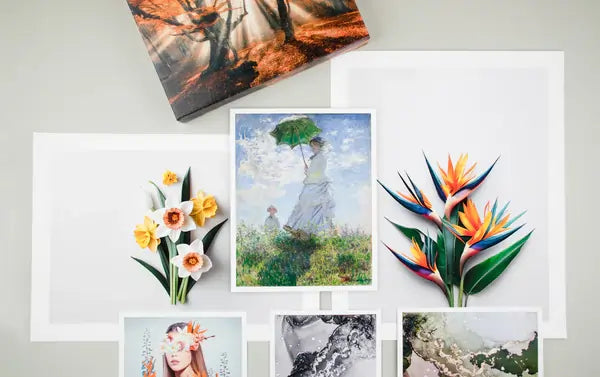Light is one of the most basic yet powerful elements of art, both inside and outside of the frame. The way light is portrayed inside a piece of art can give it depth, emotion, and visual contrast, and how the final piece is lit inside your gallery, or your home, can have similar effects.
Choosing the best lighting for your art prints can highlight their beauty, while the wrong lighting can distract. We’ll walk you through the different elements of lighting art prints and help you choose the perfect one to make your artwork shine.
The Three Elements of Gallery Lighting
When setting up lights for showcasing your art, there are three key elements you’ll need to consider to create the best lighting for your artwork:
- Quality: The quality of light refers to how “hard” or “soft” a light falls onto your print. Hard light has minimal diffusion and casts straight, clean shadows at its edges. Soft light is often created by passing light through some kind of diffusion, giving it soft shadows and less defined edges.
- Direction: The direction refers to the angle at which the light hits your print. Different angles can create different effects on your print. A light positioned directly in front of your print will increase vibrancy and eliminate shadows, while a light positioned slightly to the side will emphasize textures.
- Temperature: The color temperature of your lighting can have a drastic effect on how colors in your print are perceived. Color temperature is measured in Kelvins, with higher numbers representing a light that is cooler (closer to blue) and lower numbers representing a warmer light (closer to yellow).
Manipulating all three of these elements can drastically change how your art is perceived in space, from which colors stand out to whether your art blends with the mood of the space.

How Light Quality Affects Prints
The quality of light that falls on a print will impact shadows and colors, as well as how strongly the eye is drawn to the print. Some people prefer to have a hard light hitting their prints, which creates a dramatic “spotlight” effect with clean lines. This is great for creating a more dramatic mood on your walls and can make vibrant prints really “pop.”
Other people prefer a softer light quality, which diffuses evenly across the prints and creates a soft halo effect around it. This is great for prints that are hung in lower-lit rooms or rooms where you want to create a cozier ambiance. All types of light will affect your art and whether it the surface is matte or glossy will also change these qualities.
How Light Direction Affects Prints
Where you position your lights in relation to your prints can change what elements of your print are highlighted and also affect the light quality of your prints. If you have a textured print that you want to highlight, placing your light at a slight angle to your print will create subtle shadows that highlight the textured areas of the print.
You can also use direction and distance to control the quality of the light. If you want the light on your print to be softer, position your light further away. If you want it a bit harder, move your light closer.
How Light Temperature Affects Prints
Light temperature can have the most dramatic effect on how your print looks when it’s displayed. Because our eyes perceive colors in relation to the colors we see around them, the color temperature of the light shining on your print will literally change what colors your eyes are drawn to in your print, and which ones are muted.
A warmer color temperature will give an overall cozy, inviting vibe, but it will naturally accent reds and yellows in your print and mute blues and purples. Similarly, cooler light will make blues, greens, and purples vibrant, but reds, yellows, and golds will be toned down.
Choosing the right color temperature is a delicate balance between the color that will blend best with the décor of your room and what will highlight the colors in your artwork. If you’re not sure, choose lightbulbs that have adjustable color temperatures so you can experiment with different ranges to see what works best for your situation.
Types of Light Fixtures for Lighting Art Prints
There are a variety of lighting fixtures that can be used to light hung art prints. These include:
- Track lighting: Adjustable lamps that are mounted to a track and are great for highlighting multiple pieces of art or lighting art from multiple directions with just one fixture
- Recessed lighting: This is non-adjustable lighting embedded into the ceiling, which creates a professional “finished” gallery feel in a dedicated space.
- Picture lights: These are fixed or adjustable lamps mounted above or on the sides of your art. They focus light directly on the artwork, giving it a classic look.
- Spotlights: These are typically adjustable lights that create hard circles of light, excellent for giving a theatrical lighting effect.
- LED panels: This is one of the most modern ways of lighting art. These panels of LED lights can be placed behind the print and illuminated through it or around its edges for a futuristic look.
Still Not Sure What the Best Lighting Is for Your Artwork? We’re Here to Help!
If you’re a photographer looking for the best way to display your photographs or an art lover who wants to make their prints pop, we can help! From helping you select the right paper and ink combo to get you gallery-ready prints to advising you on the best lighting setup for your home gallery, we want to be your partner in creating a gallery worthy of your favorite pieces. Contact us here to learn more about all of our available print options and more!






Leave a Comment